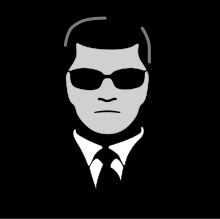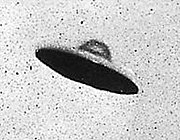Men in black

In popular culture andUFO conspiracy theories,men in black(MIB) are government agents dressed in blacksuits,who question, interrogate, harass, threaten, allegedlymemory-wipeor sometimes even assassinateunidentified flying object(UFO) witnesses to keep them silent about what they have seen. The term is also frequently used to describe mysterious men working for unknown organizations, as well as various branches of government allegedly tasked with protecting secrets or performing other strange activities.
The term is generic, as it is used for any unusual, threatening or strangely behaved individual whose appearance on the scene can be linked in some fashion with a UFO sighting.[1]Several alleged encounters with the men in black have been reported by UFO researchers and enthusiasts. The "MIB" supposedly appeared throughout different moments in history.
Stories about men in black inspired thescience fiction comedyfranchiseMen in Black,and analbumbythe Stranglers.
Folklore[edit]
FolkloristJames R. Lewiscompares accounts of men in black with tales of people encounteringLucifer,and speculates that they can be considered a kind of "psychological trauma".[2]
Ufologists[edit]
Men in black feature prominently inufology,UFO folklore, and fan fiction. In the 1950s and 1960s, ufologists adopted a conspiratorial mindset and began fearing they would be subject to organized intimidation in retaliation for discovering "the truth of the UFOs."[3]
In 1947, Harold Dahl claimed a man in a dark suit warned him not to discuss his allegedUFO sighting on Maury Island.In the mid-1950s, ufologistAlbert K. Benderclaimed he was visited by men in dark suits who threatened and warned him not to continue investigating UFOs. He maintained that the men were secret government agents tasked with suppressing evidence of UFOs. UfologistJohn Keelclaimed to have had encounters with MIB and referred to them as "demonicsupernaturals "with" dark skin and/or 'exotic' facial features. "According to ufologistJerome Clark,reports of men in black represent "experiences" that "don't seem to have occurred in the world ofconsensus reality."[4]
Historian Aaron Gulyas wrote, "During the 1970s, 1980s and 1990s, UFO conspiracy theorists would incorporate the MIB into their increasingly complex and paranoid visions."[3]
Keel has argued that some MIB encounters could be explained as entirely mundane events perpetuated through folklore. In his 1975 bookThe Mothman Prophecies,he describes a late-night outing in 1967, where he was taken for an MIB while searching for a phone to call a tow truck.[5]
In his article "Gray Barker: My Friend, the Myth-Maker," John C. Sherwood claims that, in the late 1960s, at age 18, he cooperated whenGray Barkerurged him to develop a hoax—which Barker subsequently published—about what Barker called "blackmen", three mysterious UFO inhabitants who silenced Sherwood's pseudonymous identity, "Dr. Richard H. Pratt."[6]
In popular media[edit]
The 1976Blue Öyster Cultsong "E.T.I. (Extra Terrestrial Intelligence)" contains the line: "Three men in black said, 'Don't report this.'" Their 1983 song "Take Me Away", about the singer's desire to leave Earth with "good guy" aliens, has the line: "The men in black, their lips are sealed."[7]
In 1979, British punk rock and new wave rock bandThe Stranglersrecorded a song entitled "Meninblack" for their albumThe Raven,released that year. In 1981, their concept albumThe Gospel According to the Meninblackfeatured alien visitations to Earth.[8]
James T. Flocker's 1979 filmThe Alien Encountersincluded Men in Black who harass a UFO investigator portrayed by Augie Tribach.[9]
The 1984 filmThe Brother from Another Planetfeatures two Men in Black who try to capture the alien hero. One is played by the film's director, John Sayles.[10]
The 1997 science-fiction filmMen In Black,starringWill SmithandTommy Lee Jones,was loosely based onThe Men in Blackcomic bookseries created byLowell CunninghamandSandy Carruthers.[11]Cunningham got the idea for the comic when he and a friend saw a black van on the street and his friend joked about government "men in black".[12]
See also[edit]
References[edit]
- ^Clark, Jerome (1996). The UFO Encyclopedia, volume 3: High Strangeness, UFO's from 1960 through 1979. Omnigraphis. 317–18.
- ^James R. Lewis (9 March 1995).The Gods Have Landed: New Religions from Other Worlds.SUNY Press. pp. 218–.ISBN978-0-7914-2330-1.Archivedfrom the original on 2 July 2014.Retrieved16 March2016.
- ^abAaron John Gulyas (25 January 2016).Conspiracy Theories: The Roots, Themes and Propagation of Paranoid Political and Cultural Narratives.McFarland & Company.pp. 86–.ISBN978-1-4766-2349-8.
- ^Harris, Aisha (23 May 2012)."Do UFO Hunters Still Report" Men in Black "Sightings?".Slate.Slate.Archivedfrom the original on 14 July 2014.Retrieved3 July2014.
- ^John Alva Keel,The Mothman Prophecies,Tor, 2002. Chapter 1: "Beelzebub Visits West Virginia".
- ^Sherwood, John C."Gray Barker: My Friend, the Myth-Maker".Skeptical Inquirer.Archived fromthe originalon 2011-05-12.Retrieved2006-10-10.
- ^"ShieldSquare Captcha".
- ^Twomey, Chris (1992).The Stranglers - The Men They Love To Hate.EMI Records Ltd. pp. 102–104.
- ^Godzilla, Glitter."The Alien Encounters".Retrieved2021-12-12.
- ^Vincent Canby(September 14, 1984)."Sayles'sBrother".The New York Times.Retrieved2010-08-13.
- ^David Hughes (2003).Comic Book Movies.London:Virgin Books.pp. 123–129.ISBN0-7535-0767-6.
- ^"Metamorphosis of 'Men in Black'",Men in BlackBlu-Ray
Further reading[edit]
- Clark, Jerome(1996).The UFO Encyclopedia, volume 3: High Strangeness, UFO's from 1960 through 1979.Omnigraphis.ISBN1-55888-742-3.
- Condon, Edward (1968). Gilmor, Daniel S. (ed.).Final Report of the Scientific Study of Unidentified Flying Objects.New York City:Batnam.ISBN0-552-04747-3.ISBN.
- Wallace, Chevon."Albert Bender and the M.I.B. Mystery".Bridgeport Public Schools. Archived fromthe originalon 2011-07-19.Retrieved2006-09-10.
- The Mothman Prophecies- 1975 book by John Keel an account of alleged sightings of a large, winged creature calledMothmanin the vicinity of Point Pleasant, West Virginia, during 1966 and 1967, it also narrates encounters of the author with "Men In Black"
- Los Hombres De Negro y los OVNI- 1979 book by UruguayanufologistFabio Zerpa

